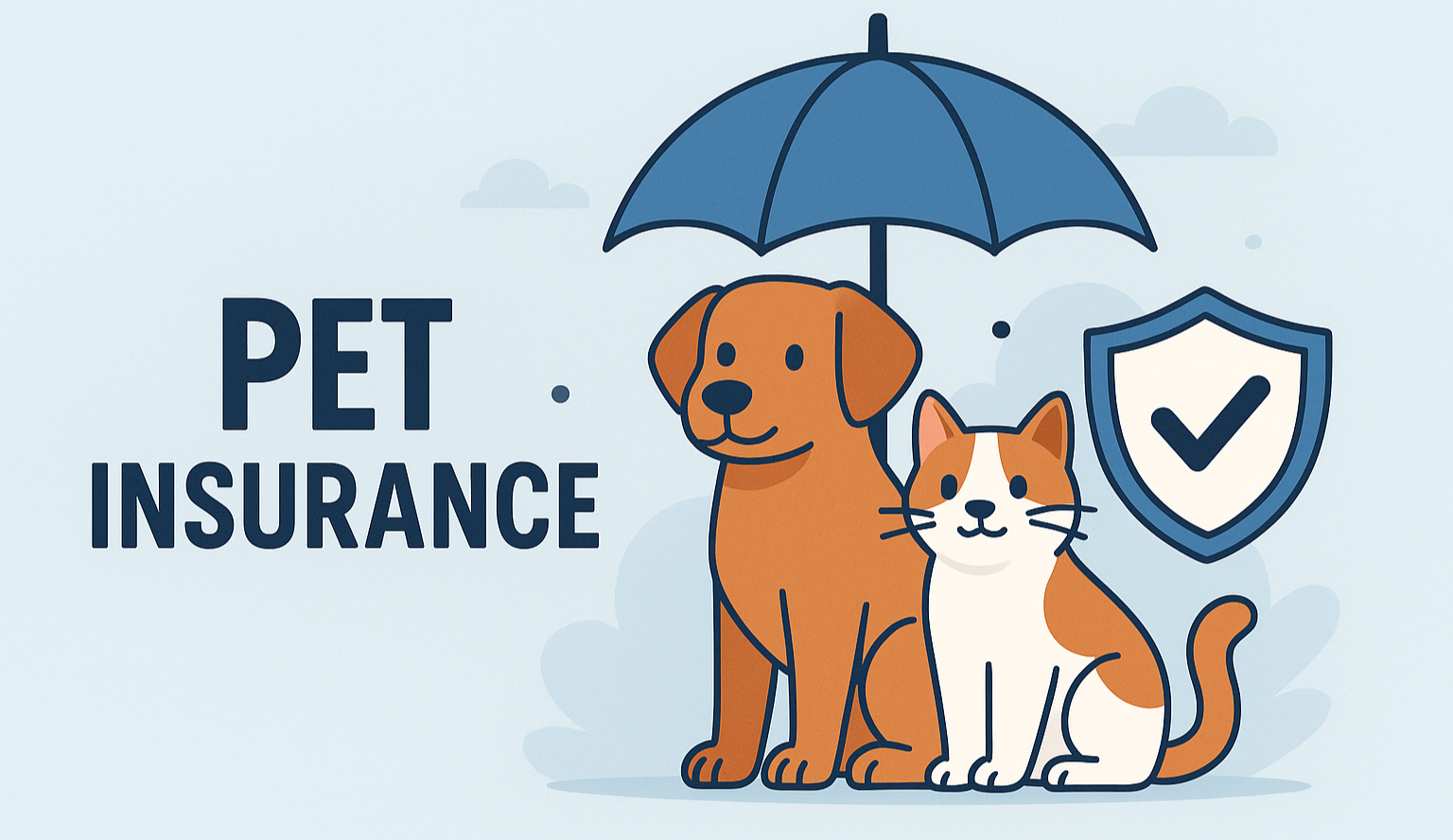
Pet Insurance in 2025: Coverage, Costs, and How to Pick the Best Plan
Pet Insurance in 2025: Coverage, Costs, and How to Pick the Best Plan
Pet insurance has gone from a “nice to have” to a smart financial safety net. Veterinary care is improving, but it’s also getting more expensive—advanced diagnostics, specialist surgeries, and chronic care can quickly strain your budget. A good pet insurance policy turns unpredictable medical bills into manageable premiums while letting you choose the best care for your dog or cat.
What Is Pet Insurance?
Pet insurance is a policy that reimburses you for eligible veterinary expenses when your pet gets sick or injured. Depending on the plan, it may also cover routine wellness, vaccinations, and third-party liability (e.g., if your dog injures someone or damages property). You typically pay the vet first and then file a claim for reimbursement.
Why It Matters in 2025
Rising vet costs: Imaging (X-rays, scans), blood panels, and specialist treatment cost more than ever.
Lifestyle diseases: Obesity, allergies, dental issues, arthritis, and diabetes are increasingly common.
Better options: Insurers now offer cashless networks, faster claim processing, and tailored add-ons.
Types of Pet Insurance Plans
1. Accident-Only
Covers injuries due to accidents—fractures, cuts, poisoning, road mishaps. It’s the cheapest entry point but excludes illnesses.
2. Accident & Illness (Comprehensive Medical)
Covers accidents plus diseases like infections, skin conditions, GI problems, ear/eye issues, cancer, etc. This is the most popular plan type.
3. Wellness/Routine Care Add-Ons
Optional add-on for vaccinations, deworming, dental cleaning, flea/tick prevention, and health check-ups. Lowers surprise costs from routine care.
4. Third-Party Liability
Covers legal liability if your pet injures a person or another animal, or damages property. Useful for large breeds or very social dogs.
5. Theft/Loss & Mortality Benefits (Selected Plans)
Provides a benefit if your pet goes missing (with police report) or dies due to accident/illness (as per policy terms).
What’s Usually Covered
Consultation fees, diagnostics, hospitalization, surgery, and prescribed medicines
Imaging (X-ray, ultrasound), lab panels, and post-operative care
Hereditary conditions (only in some plans and after waiting periods)
Emergency care and ambulance (if listed)
Alternative therapies (physiotherapy, hydrotherapy)—plan dependent
Common Exclusions
Pre-existing conditions (illnesses before policy start/waiting period)
Cosmetic/elective procedures (tail docking, ear cropping, non-medical grooming)
Breeding, pregnancy, whelping
Preventive care without a wellness add-on
Unapproved or experimental treatments
Negligence or non-compliance with vet’s advice/vaccination schedule
Always read the policy wording for exact inclusions and exclusions.
Key Terms You Must Understand
Sum Insured (Coverage Limit): The annual maximum the insurer will pay.
Deductible: The fixed amount you pay per claim or per year before insurance kicks in.
Co-pay (Co-insurance): Percentage you share on each claim (e.g., insurer pays 80%, you pay 20%).
Waiting Period: Time after purchase during which certain claims aren’t payable (e.g., 15–30 days for illnesses, 48 hours for accidents—varies).
Sub-limits: Caps on specific treatments (e.g., diagnostics or cruciate ligament surgery).
Network/Cashless: Some insurers offer cashless settlement at tied-up clinics.
How Much Does Pet Insurance Cost?
Premiums depend on:
Species & Breed: Some breeds are prone to hip dysplasia, brachycephalic issues, or skin problems.
Age: Younger pets are cheaper to insure; premiums rise with age.
Location: Urban areas can have higher vet costs.
Plan Type & Sum Insured: Comprehensive plans and higher limits cost more.
Deductible & Co-pay: Higher deductibles usually lower your premium.
Add-ons: Wellness, liability, or theft benefits increase cost.
Tip: Insure early. Buying when your pet is young helps avoid pre-existing exclusions later.
How Claims Work (Step-by-Step)
1. Get Treatment: Visit any licensed vet (or a network clinic for cashless if available).
2. Collect Documents: Itemized bill, payment receipt, prescription, diagnostic reports, case summary.
3. Submit Claim: Via app/portal/email within the specified timeframe (often 48–72 hours).
4. Assessment: Insurer checks eligibility, waiting periods, exclusions, and sub-limits.
5. Reimbursement/Cashless: Money is reimbursed to your bank account, or billed directly to the clinic if cashless.
6. Track Status: Use the app/portal for real-time updates.
How to Choose the Right Plan
Match coverage to risk: For active or large-breed dogs, consider higher limits and liability cover. Cats may benefit from strong illness coverage.
Check claim settlement experience: Look for quick TATs, app-based filing, and transparent documentation.
Look for flexible sub-limits: Avoid overly tight caps on common surgeries or diagnostics.
Mind waiting periods & pre-existing clauses: Especially for hereditary or chronic issues.
Evaluate wellness add-ons: Worth it if you consistently spend on vaccination, dental, and routine checks.
Network & cashless options: Convenient in emergencies.
Annual premium vs. out-of-pocket: Balance deductible/co-pay with what you can comfortably afford.
Smart Ways to Lower Your Premium (Without Losing Protection)
Choose a sensible deductible you can pay comfortably in emergencies.
Bundle add-ons only if you’ll use them; skip what you don’t need.
Maintain vaccination & preventive care—some insurers reward responsible pet parents.
Keep your pet’s weight in check—obesity fuels claims and complications.
Microchip & train your pet—can reduce risk and may help in theft/loss cases.
Example Scenarios (How Insurance Pays)
Foreign body ingestion (dog eats a toy): Endoscopy/surgery, hospitalization, meds. A comprehensive plan can reimburse most costs after deductible/co-pay.
Chronic skin allergies: Ongoing consultations, tests, and meds—covered under illness benefits subject to annual limits and waiting periods.
Road accident: Emergency stabilization, imaging, fracture repair—accident benefits apply; some plans include ambulance.
Mistakes to Avoid
Waiting until your pet is older—premiums rise and exclusions pile up.
Choosing the cheapest plan—low premiums often hide tight sub-limits.
Ignoring exclusions—especially hereditary, dental, or behavioral treatments.
Underinsuring: Pick a sum insured that realistically covers a major surgery + hospitalization.
FAQs
1) Is pet insurance worth it?
Yes, if a single emergency can strain your budget. Insurance protects your savings and lets you choose better care.
2) Can I insure an older pet?
Many insurers allow it but may charge higher premiums and restrict coverage. Insure early if possible.
3) Are vaccinations covered?
Usually only with a wellness add-on. Medical plans focus on accidents and illnesses.
4) What about dental treatment?
Dental accidents are often covered; routine cleaning typically needs a wellness add-on.
5) Can I use any vet?
Most plans reimburse care from any licensed vet. Cashless applies only at network clinics (if provided).
6) Are pre-existing conditions covered?
Generally no. Some insurers may cover curable conditions after a symptom-free period—check policy wording.
Bottom Line
Pet insurance turns surprise vet bills into predictable costs and safeguards your pet’s access to quality care. Compare plans, read the fine print, and pick coverage that matches your pet’s age, breed, and lifestyle. Insure early, keep records neat, and you’ll get the most value from your policy—along with the peace of mind your furry friend deserves. Best pet insurancet
More insurances Life insurance Auto insurance
Hi, I’m Waqas, the author behind EisoTech. Gaming has always been more than just a hobby for me—it’s a passion that connects people and cultures. Through this platform, I share updates, reviews, and insights about the latest trending games so fellow gamers can stay ahead of what’s new and exciting.

